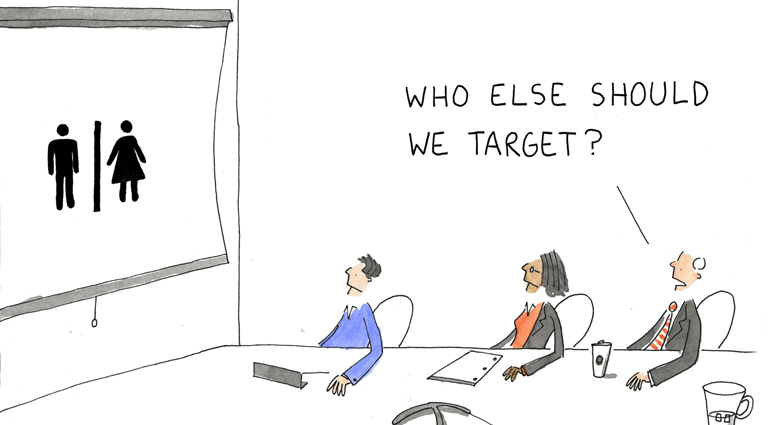Few events so clearly epitomize a nationwide conversion to brand intimacy as did the moment when seemingly every consumer in the country began referring to the Target store chain as Tar-Jay .
In the late 1990s, Target Corp.’s U.S. national image was transformed from that of a low-priced seller of detergent and T-shirts to a fashionable merchant that understood and delivered on the special demands of its shoppers—with flair, function and feasibility. In return, consumers elevated its brand equity with the chic moniker.
Don’t confuse repeat business with customer intimacy @Pearson4loyalty
Target, which will be expanding to Canada in 2013, succeeded with an ingenious and almost magical mix of merchandising, practicality and marketing. But how did it get the formula just right?
We are fortunate enough to have access to the most advanced technological resources for identifying the purchasing patterns and lifestyles of our consumers. Yet for many of us, customer intimacy continues to be an elusive goal.
Part of the reason may simply be a matter of perception. Don’t confuse repeat business with customer intimacy. Repeat business may be the simple result of a variety of functions: location, price, service or product. But it also is likely be driven by routine, needs and availability.
Intimacy, however, is when a customer chooses to stay with your brand even when an equal or potentially better alternative is available.
The solution lies in your management, strategies, employees and vision. But the tool that puts these elements to work is data. But the advanced data processes that provide such rich customer insights also contribute to privacy concerns, as well as competition from other companies that also are looking for new ways to use customer information to stand apart.
No doubt, achieving customer intimacy is a big subject. But by highlighting some of the key principles, I believe I can provide a comprehensive overview.
Build Emotional Loyalty
If customer intimacy is proof of commitment even in the face of competition, then loyalty, particularly emotional loyalty, is the result of knowing what your best customers love about you and building on that.
For example, a shopper may say she is loyal to one supermarket because she stops there every week. But in reality, she may only shop there because it is on her way home from work. What if a new superstore, perhaps Target, opened nearby? Chances are she would try it, and if she preferred the prices, selection and services, she would switch brands. So long, loyalty.
But let’s say that shopper has established a relationship with her supermarket’s pharmacist, who greets her by name. She also appreciates that its cashiers offer her coupons for the products she is purchasing. And she is impressed by the supermarket’s mailers, which recognize her shopping habits and create added value through relevant product offers and special offers.
When the bigger store opens nearby, she chooses to stay with her market. This is emotional loyalty, and to retain customer intimacy, you need to nurture this elevated level of brand commitment.
Assure You Are Relevant to Your Customers
Relevance represents the most powerful opportunity for companies to build long-term, profitable relationships. It occurs when a company is able to understand its best customers’ core interests, assign value to them, and then connect with its customers in a way that says, “I know who you are, and I understand your needs.”
Unfortunately, achieving relevance is an increasingly daunting task. As channels of communication proliferate and compete, the process of reaching the consumer is like whispering in a windstorm. The only messages that rise above the noise are those that offer solutions to specific customer needs.
This takes knowing where the consumer is at a point in time, since location and immediate needs affect how marketing messages resonate. But it also means understanding life stages—did he just move into a new house? And it requires knowledge of the customer’s personal interests and culture. You wouldn’t send the same message to a vegetarian theater buff as you would to a retired executive who just booked an African safari.
Use Data Responsibly
Having such ground-level knowledge of your best customers requires advanced data processes, and great responsibility. When consumers share personal information with you, they are entering into a value exchange, and they rightly expect something of worth in return for the data they give you.
Also, be clear with your customers about what information you are collecting, why you are collecting it and how you plan to use it. It’s basic relationship building: For consumers to trust you, you need to be honest with them. Use the data you collect only as directed and as is permissible, retain it only as long as needed, and be clear about which other parties you might be sharing the information.
Make the Loyalty Leap
The Loyalty Leap occurs when a comp redirects focus from the product to the customer @Pearson4loyalty
The Loyalty Leap occurs when a company redirects its focus from the product to the customer. It entails the release and sharing of customer data beyond the marketing department, to help influence everything from product development to store locations—what we call Enterprise Loyalty.
It takes the skillful collection, analysis and segmentation of customer data, always in the context of the consumers’ lifestyles, and then incorporating these insights throughout the organization. With such comprehensive understanding of the consumer, we can develop not only the best services or products, but also the most effective ways to communicate and present them. And we can do this not only through our direct communications, but also through our frontline workers who complete the experience.
To simplify, achieving customer intimacy is really just a matter of shifting one’s perspective from building your business from the products out to building your business from the customer. After all, if you foster customer intimacy and emotional loyalty, your best customers will help to build your empires for you.
Just ask anyone at Tar-Jay.





.png)




What Did You Think?